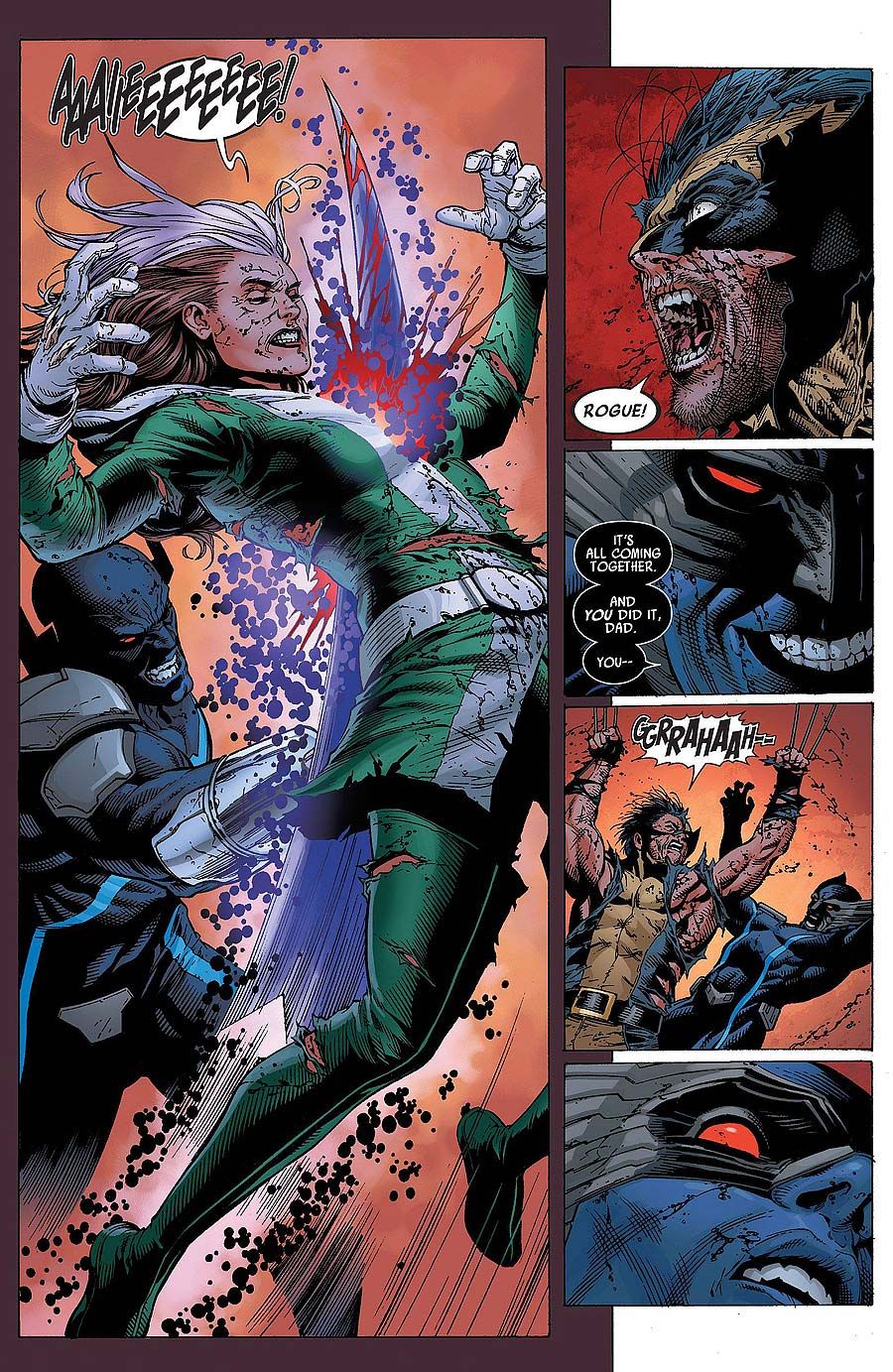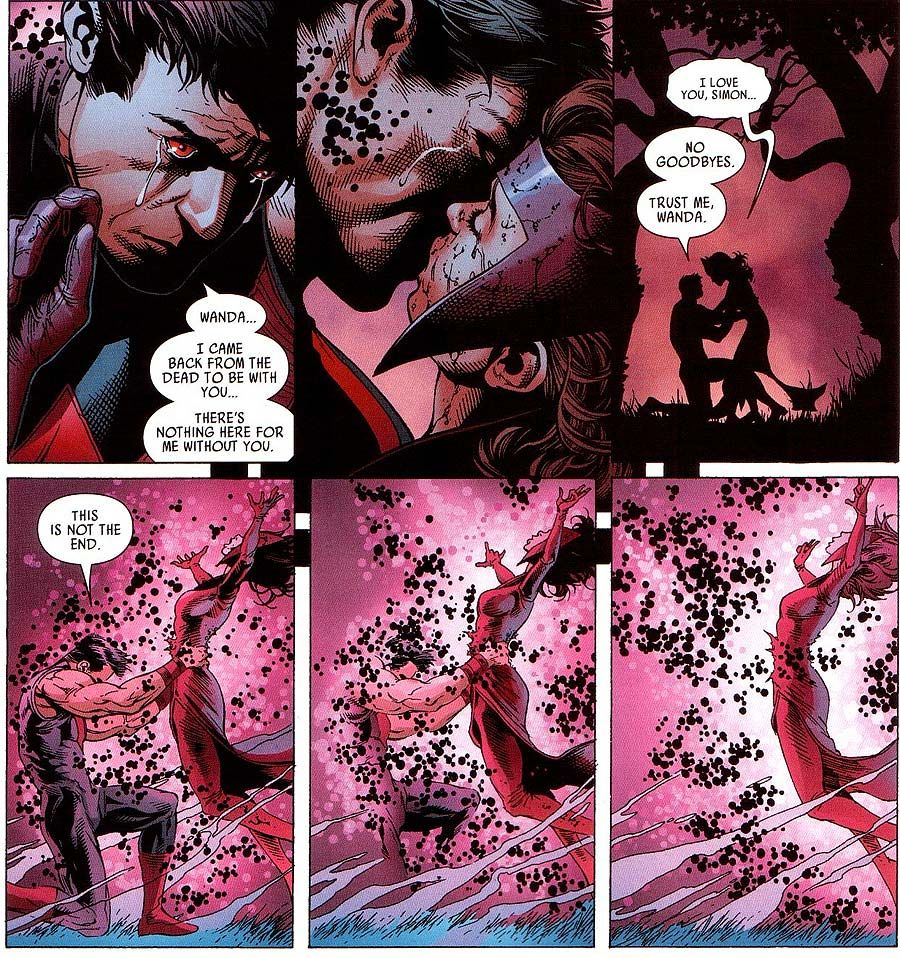It's one week after Thanksgiving, and our fridges are filled with leftovers. Unfortunately after last Wednesday, comic book fans have had to throw away some turkey to make room for some other items in the fridge. If you haven't read "Uncanny Avengers" #14, as well as "Black Science" #1, here's your spoiler warning. Please proceed with caution and an open mind.
I have to say, if you're going to have a favorite character bite the dust, maybe it's best to have it happen on the day you're driving across the country for the Thanksgiving holiday. I had a lot of time to think about the wider ramifications of "Uncanny Avengers" #14 on my own before diving into what everyone else was saying online and, as you can guess by the opening paragraph, it all just bummed me out.
I'm not big on assuming the worst in creators and I'm not big on assuming the worst in stories, so I had a lot to mull over while driving through the entire state of Ohio. So when writer Rick Remender has Rogue gut Scarlet Witch, only to then have Rogue impaled and fried on the Grim Reaper's scythe, thus killing two of the only three women on his team of nine Avengers, it's a little bit hard to divorce the larger ramifications of such an act from the story itself.
And the story itself, while maybe not to every superhero fan's taste, is compelling to me. Remender's telling one of the few classically long-game stories in comics right now, with his run on "Uncanny Avengers" picking up where his "Uncanny X-Force" left off. The plot is huge, the characters are A-List, the art is always fantastic. Despite the events of the previous paragraph, I don't think this book is all heartless shock value. Remender is a captivating, smart and entertaining writer who unleashes dense drama on readers every time a book of his comes out. His work unquestionably deserves attention, and its competence and intelligence means it deserves to be held up to crazy levels of scrutiny.
There's a trope called Women in Refrigerators, which was coined by writer Gail Simone to spotlight the disproportionate number of female characters that are de-powered, raped or killed in order to further a man's storyline. A timely example -- Barbara Gordon was paralyzed (de-powered) and victimized (possibly raped) by the Joker in order to cause Jim Gordon and Batman pain in "The Killing Joke." When word of what happened in "Uncanny Avengers" hit the internet on Tuesday -- a day before it came out, mind you -- people started to wonder how they were going to cram icons as large as Scarlet Witch and Rogue in an already crowded fridge.
RELATED: Rick Remender Discusses the Events of "Uncanny Avengers" #14
While "Uncanny Avengers" was problematic in other ways, I don't think it's fair to call it a fridge-fest just yet. For one thing, Remender has been working on the relationship between Rogue and Scarlet Witch since the first few issues. He's given these two a history, one that is based solely on their interpretations of mutantkind and their race's larger place in the world. To Remender's credit, they're not arguing over a man -- they're both portrayed as smart women who feel passionately about very important issues. Comics being comics, this led to Rogue gutting Scarlet Witch with her borrowed Wolverine claws -- but at least this wasn't because Wanda was flirting with Gambit. The two dearly departed women had agency in the issue, something that female heroes still fight to have.
We're also not shown in "Uncanny Avengers" #14 specifically how their deaths are going to up the angst for the men and further their storylines at the expense of Rogue and Scarlet Witch's. But since only 33% of the team was female to begin with, I can't imagine how a team that's only 16% female (thanks, Wasp) will not focus on the men being motivated by the grisly death of their two female teammates. The trope hasn't come true yet.
And Fridge naysayers, I know what you're thinking -- of course their teammates are going to be motivated. All comic book deaths motivate other characters! The thing is, female character deaths are rarely allowed to motivate other women. They're also rarely the type of noble sacrifices that men tend to get (like Hawkeye, Cable, Cyclops, Colossus -- I'm literally just looking around my office right now).
There's this weird desire a lot of male comic book fans have to stifle female criticism, and that has especially happened surrounding this issue. So if you're not going to listen to a woman, then listen to me (keep in mind that doing this is the definition of sexism): everyone is allowed to have opinions on comics, and other people have different experiences than you. Trust women to know more about being a woman than you, a man. The Women in Refrigerators trope exists, and it's downright dumb that people still have to prove that it exists every time another instance of it pops up.
There was also a third death in "Uncanny Avengers" #14. I'm sorry Wonder Man fans, but that hero's death only illustrates why Rogue and Scarlet Witch's ends were so controversial. A lot of anti-Fridgers are throwing around the "But Wonder Man was killed too!" phrase as if it contained mystical powers to keep feminists at bay. Wonder Man's death is not getting attention because of the nature of his death; Rogue and Scarlet Witch were violently impaled, with blood spurts and pain faces. Wonder Man evaporated. The women were brutally attacked, the man just faded into nothing.
The other thing that I think the non-reaction over Wonder Man's death highlights has to do with representation. This fan reaction is very similar to the one that happened when Annabelle Riggs was killed in "Fearless Defenders." She was immediately resurrected, yes, but fans were devastated when they thought that one of Marvel's few lesbian characters was killed. I don't think there is a single male Wonder Man fan that loves that character as much as female fans love Rogue and Scarlet Witch. That's because of representation.
Men -- specifically straight white ones -- have every big name hero out in front to idolize and relate to. Spider-Man, Superman, Batman, Thor, Captain America, Iron Man, Hulk, Flash, Green Lantern -- if you're a little boy looking to see yourself in hero form on a lunchbox or notebook, you've hit the jackpot. Now imagine you're a little girl who loves superheroes. You've got Wonder Woman, and she usually pops up wherever Superman and Batman do -- but that's nowhere near a guarantee. Then you've got Black Widow, the first legit female superhero in the Marvel Cinematic Universe, one that gets neglected pretty much any time there's an Avengers-branded anything. Hawkeye, a character who got a third of the screen time Black Widow did in "Avengers," pops up on merchandise exponentially more than she does. Boys are shown that they are the hero, girls are shown that they should either like the guy heroes or just go with the princess bed sheets corporations want her to want.
Original "Killing Joke" Art Reignites Debate About Joker's Barbara Gordon Torture
Fans my age who were introduced to comics via the '90s X-Men cartoon expect better. That cartoon featured four diverse, powerful female superheroes that were featured on branded items nearly as much as the guys were. For the first time ever, female comic book fans had heroes that looked like them and kicked just as much ass as the guys. Now, twenty years later, the most ass-kicking of those heroes was stabbed through the back by a C-Level villain. If team books contained equal representation and female heroes had as many ongoing solo books as men do, this would be less of a problem. But "Uncanny Avengers" now stars one woman and five men. No matter where the story goes, even if the story justifies these sacrifices and hits new artistic highs, it's still a bummer that this corner of Avengers Mansion is now basically a frat house.
The other point Fridge critics make is that writers should be able to kill female characters just as often as male ones. That's one hundred percent true. Rick Remender earned my trust in "Uncanny X-Force"; I know he's going somewhere with this. As a writer, one that's proven himself, he should be allowed to kill whoever he pleases. If the team had a gender ratio that reflected our actual population, or if Wonder Man's evaporation was shown to be just as painful as his female teammates' impalings, I think I'd be writing a very different article today.
Regular readers of this column (I'm thankful for you, by the way) have seen all of these arguments before. I've written pretty much the same thing over and over again. I don't like doing it, but I feel I have to do it because comic books keep doing the same things. In fact, Rick Remender's other comic from last week, the absolutely gorgeous and compelling "Black Science," Fridged a female character. Jen, a scientist colleague of lead character Grant, gets shot through the face on the sixth page. Up to that point, we know two characters: Grant and Jen. Grant, a white male character, lives, while Jen, the white female character, gets killed. Just five pages later, Grant thinks to himself, "I knew the risks. Jen did as well. Make her sacrifice matter." That is textbook fridging.
Here's the thing to remember when reading criticisms like this: using a trope does not automatically equate to a comic being bad. "Star Wars," pretty much everyone's favorite movie, is the headliner at Trope-a-palooza. Both "Uncanny Avengers" and "Black Science" are well-crafted stories, and they're two of the most passionate comics out there. They both just so happen to include -- and potentially include in "Uncanny Avengers'" case -- a trope that comic books have overused. I mean, the trope was named after an incident in a comic book. I'm tired of writing this piece, and I can't imagine how comic book writers aren't sick of killing women to further a man's story.
Let's keep our fridges clean in 2014, comics.
Brett White is a comedian living in New York City. He co-hosts the podcast Matt & Brett Love Comics and is a writer for the comedy podcast Left Handed Radio. His opinions can be consumed in bite-sized morsels on Twitter (@brettwhite).



